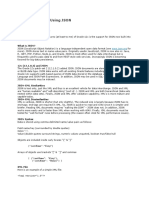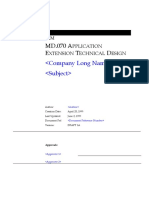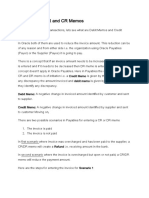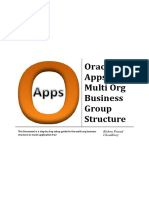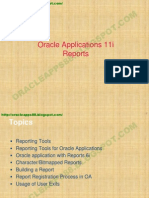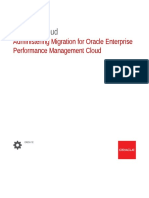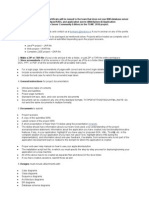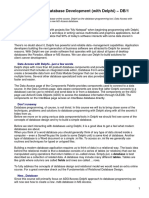GL Interface: GL - Je - Source - TL - Unique 6) Jecategoryname - Unique GL - Code - Combinations
GL Interface: GL - Je - Source - TL - Unique 6) Jecategoryname - Unique GL - Code - Combinations
Uploaded by
Phanendra KumarCopyright:
Available Formats
GL Interface: GL - Je - Source - TL - Unique 6) Jecategoryname - Unique GL - Code - Combinations
GL Interface: GL - Je - Source - TL - Unique 6) Jecategoryname - Unique GL - Code - Combinations
Uploaded by
Phanendra KumarOriginal Title
Copyright
Available Formats
Share this document
Did you find this document useful?
Is this content inappropriate?
Copyright:
Available Formats
GL Interface: GL - Je - Source - TL - Unique 6) Jecategoryname - Unique GL - Code - Combinations
GL Interface: GL - Je - Source - TL - Unique 6) Jecategoryname - Unique GL - Code - Combinations
Uploaded by
Phanendra KumarCopyright:
Available Formats
http://oracleapps88.blogspot.
com/
Raju Ch
GL Interface
Procedure:
1) We populate the Staging Table
2) Performed Validation on Staging Table.
3) Populate GL Interface
4) Used Concurrent Program : Journal IMPORT.
5) Report Used is : Journal Import Execution Report That gives Info on failed import.
6) If we get few errors, then we fix the errors in GL_Interface.
7) If we get many Errors: Then we delete IMPORT Journals using
Concurrent Procss : Delete Journal Import Data.
- we clean the GL_Interface
- Fix the data from the Source and start over.
8) Post Journal Entries after successful Import.
Interface Tables: GL_INTERFACE
Base Tables
.C
GL_JE_BACTHES,
GL_JE_HEADERS,
GL_JE_LINES.
[ GL_JE_Set_Of_Books, Gl_Code_Combinations, GL_JE_Source_TL, GL_JE_Categoies_TL,
GL_Periods, fnd_Currencies ]
Staging Table Cols : AccountingDate, DateCreated, ActualFlag, CategoryName, SourceName,
Entered Debit/Credit, Segments 1-5, References 21-27,CCID, ProcessFlag, ErrorMsg.
(New, Yes ,Error)
Interface Cols : Status, SetOfBooksID, AccountingDate, CurrencyCode, DateCreated,
CreatedBy, ActualFlag, UserJECategorName, UserJESourcename, Entered Debit/Credit,
Segments 1-5, References 21-27.
.B
8
Concurrent Program: Journal Import
Journal Posting --- Populates GL_BALANCES
Validations:1) JeHeaderID <GL_JE_Headers>
-Unique
2) JeBatchID <GL_JE_Batches>
-Unique
3) JeLineNum <GL_JE_Lines>
-Uniqueness of HeaderID.
-- The Amount of the lines should match the total Amt of
Header.
4) SetOfBooksID <GLJESetOfBooks>
-It has to exist to the set of Books Table.
5) JESourceName <GL_JE_Source_TL>
-Unique
S
P
A
E
6)JECategoryName <GL_JE_Categoies_TL>--
Unique
7) CurrencyCode <Fnd_Currencies>
-It has to be defined
8) PeriodSetName + Period_Name <GLPeriod> -Should be open and defined.
9) CodeCombinationId < Gl_Code_Combinations > -- Should exist in Chart of Accounts.
Validations Type:
1) Batch Level: a) SOB
b) BatchName
c) PeriodName
This is done to ensure that batch doesnt exist already.
2) Journal Level:
Journal Entry Name, Currency Code, Accouting Date
3) Accounting Validations / Journal Entry Line level Validation
Code Combination ID: 1) Should be enabled in Accounting Date.
Validations for the staging table:
Check if the inputted data file is already uploaded into staging table.
http://oracleapps88.blogspot.com/
Raju Ch
Check if the record already exists in the interface table.
Check if the journal already exists in the GL application.
AP Invoice Interface
Interface Table:
AP_INVOICES_INTERFACE,
AP_INVOICE_LINES_INTERFACE,
AP_INTERFACE_REJECTION,
AP_INTERFACE_CONTROL
(AP_INTERFACE_CONTROL: This is a Temp table that holds control information about
segregated data in AP_INVOICES_INTERFACE table during payable open interface import. This
table ensure each import is unique With respect of combination of SOURCE & Group_ID.)
Base Table:
AP_INVOICES_ALL
AP_INVOICE_DISTRIBUTIONS_ALL
AP_PAYMENTS_SCHEDULE_ALL
Staging Table Col: Vendor#, Invoice#, InvoiceAmt, InvoiceDate, Qty, UnitPrice, InvoiceLineAmt,
InvoiceLineDesc, Batch#, Status, CreationDate.
Interface Cols:
<AP_INVOICES_INTERFACE>:
InvoiceID, InvoiceDate, CreationDate, CreatedBy,
LastUpdateDate, LastUpdatedBy, InvAm, VendorID, VendorSiteID, Inv#,
Source, AcctsPayCodeCombinationID [Under what Account u r making
payment], InvCurrencyCode.
<AP_INVOICE_LINES_INTERFACE>: InvoiceID, DistCodeCombinationID, Desc, Amt,
CreationDate, CreatedBy, LastUpdateDate, LastUpdatedBy, LineTypeLookupCode.
.B
8
Concurrent program: Payables Open Interface Import
Validations:
(A) <AP_INVOICES_INTERFACE>
Interface Columns
Invoice Num
Null
(AP_Invoice_All)
PO Number
Null
Vendor Name
Null
Vendor Site ID
Null
PaymentMethodLookupCode Null
Base Table
APInvoiceAll
APInvoiceAll
Interface Col
InvoiceDate
InvoiceTypeLookupCode
APInvoiceAll
VendorID
APInvoiceAll
InvoiceAmt
APInvoiceAll
Source
APInvoiceAll
OrgID
Primary Key InvoiceID
Validations
Required if there is more than 1 Invoice for the Supplier.
Must be unique for supplier
Validated against Segment1 <PO_Headers>
One of the thing is reqd Vendor ID, NUM or Name.
Validated against VendorSiteID <PO_Vendor_Sites>
Validated against <AP_Lookup_Code> - Check, Wire, EFT
S
P
A
E
8
-
(B) <AP_INVOICE_LINES_INTERFACE>
.C
-- Header information,
-- Lines info
Validations
Value must be valid date format
Value must be Standard or Credit . If InvAmt <0
then Credit, else Standard
Must be existing valid Supplier vendorID
<PO_Vendors>
Value must be equal the um of Amount values in
AP_Invoice_Lines_Interface for lines with the same
InvoiceID.
Lookup value must have Type SOURCE, otherwise
u have to define the source n Payables Lookup
Window.
http://oracleapps88.blogspot.com/
Interface Columns
Invoice ID
Receipt Number
NN
NN
Accounting Date
PO Number
Po Distribution ID
N
N
N
Dist Code Combination ID
Base Table
AP_
Invoice_
Lines_
Interface
Validations
Validated against <AP_Invoice_Interface>
To which Invoice ill be match. Validated
<RCV_Shipment_Headers>
Must be valid date format.
Validated against Segment1 <PO_Headers_All>
Used
for
PO
Matching.
Validated
<PO_Distribution_All>
Validated against GL CCID.
Interface Col
Line Group Number
Amount
against
against
Validations
Value must be positive #
Amount = Qty invoiced * Unit Price.
If total Amt != Amt of Invoice Header under the same
invoiceID, then Import Program will reject the invoice.
Must be positive for + Amt. And negative for Amt.
Account code should be valid.
Qty Invoiced
Balancing Segment
RCV Transaction ID
CCID
Raju Ch
Procedure : Payable Open Interface is used to create invoices from Invoice records in the
payable open interface Table. During import payable, we validate invoice Records and rejects
invoice records that have insufficient record or data. Successfully imported invoices have
distributions and have schedule payments and can be queried, modified and approved in the
invoice work bench.
.B
8
1) We get files from different sources e.g. Flat Files or EDI.
2) We load the data into staging table, then validate the data and then insert the data into
S
P
AP_Invoice_Interface and AP_Invoice_Line_Interface; And submit to the Payable Open
Interface Import Program.
3) If the status = Processed then
Submit Invoice validation process to validate (Approve) the invoice.
If the status = Rejected then
- Fix the invoices in AP_Invoice_Interface
- Resubmit Payable Open Interface Program.
A
E
.C
http://oracleapps88.blogspot.com/
Raju Ch
AR Auto LockBox
Definition: AutoLockbox is a service that commercial bank offers to corporate customers for
outsourcing their Accounts Receivables payment processing. We can use
AutoLockBox for historical data conversion. We can only load Cash Receipts, not
miscellaneous receipts as there is no invoice & customers.
Set Ups done before using Autolockbox Prog:
1) Set Up Receipt Bank : We define Bank with Account Use: Internal where checks from
2)
3)
4)
5)
.B
8
[ Define LockBox tells how Lockbox will handle Invalid Transaction Number.
1. Post Partial Amount as Unapplied: Apply the receipt to the valid transactions, then import the
remaining receipt amount with a status of Unapplied.
2. Reject Entire Receipt: It doesnt import the invalid receipt and data will remain in Interface
table [ Ar_Payments_Interface ]. We can edit the invalid records in the Lockbox Transmission
Data Window, then resubmit the validation step for the receipts before Lockbox can import it into
Receivables.
]
S
P
A
E
Process:
1) We create Control File for flat data file, we get from bank.
2) Move the .dat file and .ctl file to $AR_TOP/bin
3) After that we first do Import, then validation and finally Post QuickCash.
AutoLockBox is a three step Process:1. IMPORT During this step, Lockbox reads and formats the data from our bank file into
Interface table < AR_PAYMENTS_INTERFACE_ALL> using a SQL*Loader script.
2. Validation This checks data in the interface table for compatibility with Receivables. Once the
data is validated , the data is transferred into QuickCash tables [Receipt Tables]
(AR_INTERIM_CASH_RECEIPTS_ALL, AR_INTERIM_CASH_RCPT_LINES_ALL).
3. Post Quick Cash - It applies the receipts and update our customers balances, So data goes
to Base tables.
Interface tables:
AR_PAYMENTS_INTERFACE_ALL
AR_INTERIM_CASH_RECEIPTS_ALL
AR_INTERIM_CASH_RCPT_LINES_ALL
.C
customers are deposited. [ ARSetUpReceiptsBank ]
Set Up Receipt Class : Here we assign Payment methods. [SetUpReceiptsClass]
Set Up Receipt Source: We define Receipt Batch Source and assign Receipt Class,
payment
method and Bank Account to this source. [Set upReceipts Receipt Source ]
Define LockBox : Define Lockbox to use the Receivable AutoLockbox Program.
[Set UpReceipt LockBoxes Lockbox ]
Define Transmission Format : Autolockbox uses Transmission format for importing data
into receivables. Here we define Lockbox Header, Payment,
Lockbox Trailer.
[ Setup ReceiptLockboxTransmission Format ]
http://oracleapps88.blogspot.com/
Base Tables:
Raju Ch
AR_CASH_RECEIPTS_ALL,
AR_CASH_RECEIPTS_HISTORY_ALL,
AP_RECEIVABLES_APPLICATION_ALL
Interface table Cols:
For Header: Status, Record Type, LockBox#, Deposit Date, Origination.
For Payment: Status, Record Type, Customer#, Invoice1, Check#, Remittance Amt, Receipt
Date, Item Number, LockBox Number.
For Trailer: Status, RecordType, LockBox#, Deposit Date, BatchRecordCount, BatchAmt,
Origination.
Validations:
(A) < AR_PAYMENTS_INTERFACE_ALL >
Base Tables
Interface Cols
Record Type
-- [ TransmissionRecordID Pk ]
Validations
Is NN. Type of Record should
exist.(Header(HE) / Payment (DE)/
Trailer (TR))
LockBox Number
Should Exist.
Deposit Date
Should be there. Entered by user using
Maintain Lockbox Transmission Date.
Origination
-- do -Trans Routing#
-- do --
AR_Batches
AR Transmissions (Origin)
AP Bank Branches
(Bank Name, Bank Branch
Name, Bank #)
AR Cash Receipt
Receipt Date
.B
8
O-- do --
(B) < AR_INTERIM_CASH_RECEIPTS_ALL > -- [Cash Receipt ID Pk]
Base Tables
Validations
Cash receipt ID
NN Exists
Amount
NN Should be there.
Currency Code
NN Should exist in Fnd_Currencies.
GL Date
NN Should be open.
Receipt Method ID
NN Payment Method shod be specified.
Remittance Bank Account ID
NN Shod have Bank Account, Assigned to receipt.
Whos Columns
NN
Customer Trx ID
N
Should be there
Receipt Number
N
Receipt# - with Cash receipt should be there.
S
P
A
E
(C) <AR_INTERIM_CASH_RCPT_LINES_ALL>-[Cash_Receipt_ID, Cash_Receipt_Line_ID-Pk]
Base Tables
Validations
Cash Receipt ID
NN Should exist. Cash Receipt associated with Line.
Cash receipt Line ID
NN Identifier of the individual, Cash_Receipt_Lines_All
Payment Sequence ID
NN Should be there
Whos Column
NN Should be there
Sold to Customer
N
Identified of the customer. Associated with the
Customer Trx ID
Interim_Cash_Receipt_Line.
Should be there
.C
http://oracleapps88.blogspot.com/
Raju Ch
AR Auto Invoice Interface
SetUp Needed :
1) Define Transaction [i.e Invoice ] Source : [ Set UpTransactionSources ]
2) Define Transaction Flexfield [i.e DFF] : [ Set Up FinancialDescriptiveSegments
.C
Process:
1) Created Staging Table and then its Synonym in Apps schema.
2) Using SQL*Loader, populate staging table.
3) Run the AutoInvoice Interface (i.e pakage we created ) to populate Interface tables.
4) Run the Concurrent Prog : AutoInvoice Master Program for importing to Base Tables.
5) If we get any error, we can use AutoInvoice Correct Form to fix the errors.
Interface tables:
Base tables:
RA_INTERFACE_LINES_ALL,
RA_INTERFACE_DISTRIBUTIONS_ALL
RA_INTERFACE_SALESREPS_ALL
.B
8
RA_CUSTOMER_TRX_ALL,
RA_CUSTOMER_TRX_LINES_ALL
RA_CUST_TRX_GL_DIST_ALL
RA_CUSTOMER_TRX_LINE_SALESREPS
S
P
Staging Table Col: Customer#, CustomerName, ItemDesc, Ref#, Amt, TrxDate, TrxType, Line#,
StatusMsg.
Interface Table Cols:
<RA_INTERFACE_LINES_ALL>
BatchSourceName, SOBID, LineType, Desc, CurrencyCode, Amt,
CustTrxTypename, TermName, OrigSystemBillCustomerRef,
OrigSystemBillAddressRef, ConversionType,ConversionRate, TrxDate, GLDate,
Qty, OrgID, InterfaceLineAttribute 1-4, InterfaceLineContext.
<RA_INTERFACE_DISTRIBUTIONS_ALL>
A
E
InterfaceLineAttribute 1-4, Account Class, Org ID, Amount, CCID.
Concurrent Program: Auto Invoice Master Program
Validations:
Check for amount, batch source name, conversion rate, conversion type.
Validate orig_system_bill_customer_id, orig_system_bill_address_id,
validate quantity,
Validate if the amount includes tax flag.
(A) <RA_INTERFACE_LINES_ALL>
Base Table
Interface Columns
<RA Customer Trx All>
<RA Batches All>
Batch Source ID
Validations
Must exist in RABatchSourcesAll
(Name).
BatchSourceType = Foreign.
http://oracleapps88.blogspot.com/
(Exchange Rate)
Batch Source Name
SOB ID, Line Type, Desc,
Currency Code,
Conversion Type, Trx Date,
Receipt Method Name,
Interface Status
Conversion Rate
Exchange Rate Type
Conversion Type
(Revenue Amount)
Amount
(Extended Amount)
Amount
Raju Ch
All are Not Null Columns.
If conversion type = user then this
column must not be null, otherwise it
must be null.
Must
exist
in
<GL_Daily_Conversion_Types>
If LineType = Charges Then this col
must be NULL.
When
Create_Clearing=No
then
AutoInvoice will correct the Revenue
Amounts that have the wrong currency
precision.
When Create_Clearing=No then
It will go to Revenue Amount
<RACustomerTrxLinesAll>
.C
Accounting Rule Duration
Accounting Rule ID
(B) <RA_INTERFACE_DISTRIBUTIONS_ALL> : If in Auto-Invoice, we choose Auto-Accounting,
Then we dont need this Interface.
Base Table
Interface Cols
Validations
RA_Cust_Trx_Line_GL_dist_All
Account Class
Must be either Rev, Freight,
Tax, Rec, charges, UnBill, or
Unearn.
CCID
Must
exist
in
<GLCodeCombinations>.
RA_Customer_Trx_Lines_All
Interface Line Context
If we pass lines with
GlobalContext, then we have
to set this col to Global Data
Elements
Percent
The Sum of ll Accunting
distribution percentages for a
Trx must sum to 100 for an
account class.
Segment 1-6
Valid
combination
of
(If we have 6 Accounting Accounting Flexfield segment
Flexfield Segments)
value
must
exist
in
<GLCodeCombinations>.
.B
8
S
P
A
E
Whos Column :- Last Updated By, Llast Update Date, Created By, Creation Date are Nulls here.
http://oracleapps88.blogspot.com/
Raju Ch
customer API
(Every API has 3 out Parameters Return_Status, Msg_Count, Msg_Data)
.C
Algorithm Used in API is:
1) We create a record variable of the desired type (Party /Organization)
2) Then we Populate the record with information from source.
3) Then Call the Procedure to create Party / Organization and pass the record to the
procedure as a parameter so that procedure put the information of the record variable
in the base table.
1. Set the organization id
Exec dbms_application_info.set_client_info(204);
2. Create a party and an account
a) HZ_CUST_ACCOUNT_V2PUB.CUST_ACCOUNT_REC_TYPE
b) HZ_PARTY_V2PUB.ORGANIZATION_REC_TYPE
c) HZ_CUSTOMER_PROFILE_V2PUB.CUSTOMER_PROFILE_REC_TYPE
.B
8
HZ_CUST_ACCOUNT_V2PUB.Create_Cust_Account() Cust_Account_ID, Account#, PartyID, Party#.
S
P
3. Create a physical location
a) HZ_LOCATION_V2PUB.LOCATION_REC_TYPE
HZ_LOCATION_V2PUB.Create_Location(..) Location_ID
A
E
4. Create a party site using party_id you get from step 2 and location_id from step 3.
a) HZ_PARTY_SITE_V2PUB.PARTY_SITE_REC_TYPE
HZ_PARTY_SITE_V2PUB.Create_Party_Site( Party_ID, Location_ID )
Party_Site_ID, Party_Site#
5. Create an account site using account_id you get from step 2 and party_site_id from step 4.
a) HZ_CUST_ACCOUNT_SITE_V2PUB.CUST_ACCT_SITE_REC_TYPE
HZ_CUST_ACCOUNT_SITE_V2PUB.Create_Cust_Acct_Site(Cust_Acct_ID, Party_Site_ID)
Cust_Acct_Site_ID
6. Create an account site use using cust_acct_site_id you get from step 5 ans site_use_code =
BILL_TO.
a) HZ_CUST_ACCOUNT_SITE_V2PUB.CUST_SITE_USE_REC_TYPE
b) HZ_CUSTOMER_PROFILE_V2PUB.CUSTOMER_PROFILE_REC_TYPE
HZ_CUST_ACCOUNT_SITE_V2PUB.Create_Cust_Site_Use(Cust_Acct_Site_ID)
Site_Use_ID
http://oracleapps88.blogspot.com/
Raju Ch
Interface Table: TCA API.
Base table:
HZ_PARTIES
HZ_PARTY_SITES
HZ_LOCATIONS
HZ_CUST_ACCOUNTS
HZ_CUST_SITE_USES_ALL
HZ_CUST_ACCT_SITES_ALL
HZ_PARTY_SITE_USES
Validations:
Check if legacy values fetched are valid.
Check if customer address site is already created.
Check if customer site use is already created.
Check is customer header is already created.
Check whether the ship_to_site has associated bill_to_site
Check whether associated bill_to_site is created or not.
Profile amounts validation:
validate cust_account_id, validate customer status.
Check if the location already exists in HZ_LOCATIONS. If does not exist, create new location.
.C
.B
8
S
P
A
E
http://oracleapps88.blogspot.com/
Raju Ch
On-Hand Quantity Interface (Inventory)
Interface Table :
Base Tables:
.B
8
MTL_Transactions_Interface,
[ MTL_Transaction_Lots_Interface,
MTL_Serial_Numbers_Interface ]
MTL_On_Hand_Quantities,
[ MTL_Lot_Numbers,
MTL_Serial_Numbers ]
Staging Table Cols : Org Code, Item No, Source Code, Qty, UOM Code, Sub Inventory, Source
HeaderID, Source LineID, Trx Cost, Process Flag, Error Msg,
Interface Table Cols : All Not Null Columns Down
S
P
Validations:
1) Valid Organization_Code
Organization_Code <MTL_Parameters>
2) Valid Inventory Item#
Segment1 <MTL_System_Items_B>
3) Valid SubInventory Code Secondary Inventory Name<MTL_Secondary_Inventories>
4) Valid Transaction UOM
UOM_Code <MTL_Units_Of_Measure>
A
E
Interface Columns
Source code, source lineID,
Source HeaderID, whos col,
Trx qty, Trx UOM,
Trx Date
Process Flag
Transaction Mode
Lock Flag
Organization ID
TRx Type ID
Validations
NN
NN
NN
NN
N
NN
NN
.C
Oracle Inventory provide an open interface for us to load transaction from external application
and feeder system. These transaction could be sales orders, shipment transaction from an Order
Entry System, [or they could be simple material issues, receipts or transfers loaded from data
collection devices.]
Valid Date Format
1- Ready for Process by Trx Mgr, 2- Not Ready, 3-Error
2 - Run Interface Table in Concurrent Prog (submit
Manually the Concurrent Prog)
3 Run in Background Process (occurs Automatically )
1 Lock, 2 or Null Not Lock. Should always specify 2.
Should be valid
[ The Transaction Mgr picks up the rows to process based on the Process Flag and Transaction
Mode to manipulate the records in table. ]
http://oracleapps88.blogspot.com/
Raju Ch
.C
PO Requisition Import
Interface tables: PO_REQUISITIONS_INTERFACE_ALL
Base tables:
Columns of Interface Table:
Interface Source Code
Destination Type Code
Quantity
Authorization Status
Source Type Code
Req Destination ID
Validations:
NN
NN
NN
NN
N
N
Interface Transaction Source
Requisition Destination Type
Qty Ordered
Status
Requisition Source
Req Distribution Unique Identifier
.B
8
S
P
Check for interface transaction source code,
Check for requisition destination type.
Make sure the currency code exist in Fnd_Currencies.
Check for quantity ordered,
Check for Authorization status type.
A
E
PO_REQUISITIONS_HEADERS_ALL,
PO_REQUISITION_LINES_ALL
PO_REQ_DISTRIBUTIONS_ALL
You might also like
- Payables Open Interface ProgramDocument3 pagesPayables Open Interface ProgramameybaraskarNo ratings yet
- Oracle Apis and Open InterfacesDocument4 pagesOracle Apis and Open InterfacesNisheeth RanjanNo ratings yet
- Conversions and Interfaces: Dell 2000 BooksDocument7 pagesConversions and Interfaces: Dell 2000 BooksMadhu Sudan ReddyNo ratings yet
- Many Thanks To Rakesh Sreenivasa For Contributing Yet Another Article For Get Apps TrainingDocument39 pagesMany Thanks To Rakesh Sreenivasa For Contributing Yet Another Article For Get Apps TrainingPILLINAGARAJUNo ratings yet
- Inventory On Hand Migration Oracle AppsDocument11 pagesInventory On Hand Migration Oracle Appspriyanka5320% (1)
- Export Data From Excel To Table Using Custom Web ADI IntegratorDocument23 pagesExport Data From Excel To Table Using Custom Web ADI Integratorvedavyas4funNo ratings yet
- Migration StepsDocument9 pagesMigration StepsJegan NagarajanNo ratings yet
- Dbaas API CookbookDocument30 pagesDbaas API CookbookAngel Freire RamirezNo ratings yet
- R12 Uploading A Journal Using Web ADIDocument12 pagesR12 Uploading A Journal Using Web ADIdevender143No ratings yet
- All ApiDocument51 pagesAll ApiPiyush KulkarniNo ratings yet
- Form Personalization in Oracle AppsDocument14 pagesForm Personalization in Oracle AppsRabindra P.SinghNo ratings yet
- API Code For FADocument21 pagesAPI Code For FAkrishnaNo ratings yet
- Item Import OverviewDocument20 pagesItem Import OverviewSatya NarayanaNo ratings yet
- Data Flow From SLA To GLDocument3 pagesData Flow From SLA To GLRangaNo ratings yet
- Oracle R12 Payments - 1heiDocument53 pagesOracle R12 Payments - 1heiporlanageshNo ratings yet
- Data Conversion, Migration and Interface ..Why Important: June 9th, 2007Document6 pagesData Conversion, Migration and Interface ..Why Important: June 9th, 2007Ajay DograNo ratings yet
- AP Test Plan PRTMDocument23 pagesAP Test Plan PRTMajaythaneNo ratings yet
- APPENDIX E: Supporting Document (1) : MD050 - Functional Design Disbursement VoucherDocument10 pagesAPPENDIX E: Supporting Document (1) : MD050 - Functional Design Disbursement VouchermaksuhailNo ratings yet
- Case Study of PO Purchase Order Using Open Interface TableDocument21 pagesCase Study of PO Purchase Order Using Open Interface TableshrikantNo ratings yet
- P2P Cycle - DevenderDocument6 pagesP2P Cycle - DevenderyadavdevenderNo ratings yet
- Oracle ERP M50Document8 pagesOracle ERP M50ghouseNo ratings yet
- EBS2-Application Object LibraryDocument55 pagesEBS2-Application Object LibraryJun ZhuNo ratings yet
- Why Oracle?: Customer Relationship ManagementDocument3 pagesWhy Oracle?: Customer Relationship ManagementGangadri524No ratings yet
- Oracle Applications Technical ConsultantDocument5 pagesOracle Applications Technical ConsultantRamesh Babu KadiyamNo ratings yet
- SLA - High LevelDocument65 pagesSLA - High Levelzeeshan78No ratings yet
- 121 Bip ReportsDocument617 pages121 Bip ReportsMuhammad NadeemNo ratings yet
- Preface in This Book I Have Explained About A Complete Beginners Guide For Oracle Apps. Hope This Will Be A Great Start For BeginnersDocument209 pagesPreface in This Book I Have Explained About A Complete Beginners Guide For Oracle Apps. Hope This Will Be A Great Start For BeginnersredroNo ratings yet
- Cross Validation Rules in Oracle Apps - Oracle Apps Knowledge SharingDocument4 pagesCross Validation Rules in Oracle Apps - Oracle Apps Knowledge SharingVijay KishanNo ratings yet
- XX - Attachment: Attachemt Creation - Date Created - by Last - Update - Date Last - Updated - by Last - Update - LoginDocument6 pagesXX - Attachment: Attachemt Creation - Date Created - by Last - Update - Date Last - Updated - by Last - Update - LoginMbade NDONGNo ratings yet
- Inv DS-030 Application Setup Document PT PDFDocument271 pagesInv DS-030 Application Setup Document PT PDFMauriceNo ratings yet
- How To Create A Manual Transaction and Pay Commission in Oracle Incentive Compensation Release 12 (ID 1248974.1)Document6 pagesHow To Create A Manual Transaction and Pay Commission in Oracle Incentive Compensation Release 12 (ID 1248974.1)Tarun JainNo ratings yet
- Fulfillment in Oracle Order ManagementDocument9 pagesFulfillment in Oracle Order ManagementAlok Kumar100% (2)
- Oracle 12c SQL JSONDocument6 pagesOracle 12c SQL JSONrv90470No ratings yet
- API DocumentDocument23 pagesAPI DocumentKarthik ManigandanNo ratings yet
- MD070 Application Extensions Technical DesignDocument16 pagesMD070 Application Extensions Technical Designgaurav123123No ratings yet
- Professional Summary:: Oracle Apps Technical ConsultantDocument4 pagesProfessional Summary:: Oracle Apps Technical ConsultantAnuNo ratings yet
- Web ADI - Oracle Custom WEB ADI Setups and Process For AP Invoice InterfaceDocument43 pagesWeb ADI - Oracle Custom WEB ADI Setups and Process For AP Invoice InterfaceHari HariNo ratings yet
- Ar SetupsDocument35 pagesAr Setupssurinder_singh_69No ratings yet
- Oracle Apps R122ado PDF FreeDocument147 pagesOracle Apps R122ado PDF Freeherculean2010No ratings yet
- OAF Introduction: Learn Share ConnectDocument17 pagesOAF Introduction: Learn Share Connectshyam123gNo ratings yet
- Lucas Technical Specifications To: Report To Show All The Cleared Invoices Sorted by Invoice GroupsDocument16 pagesLucas Technical Specifications To: Report To Show All The Cleared Invoices Sorted by Invoice Groupspasupuletiashok164No ratings yet
- Code To Create Move Orders From Internal RequisitionsDocument28 pagesCode To Create Move Orders From Internal Requisitionsshameem_ficsNo ratings yet
- Item Import Migration Oracle AppsDocument13 pagesItem Import Migration Oracle Appspriyanka532No ratings yet
- GL InterfaceDocument17 pagesGL Interfacesrikanth_4allNo ratings yet
- 1.aim MethodologiesDocument5 pages1.aim MethodologiesAliNo ratings yet
- Tips and Tricks For Oracle FsgsDocument37 pagesTips and Tricks For Oracle Fsgsjitinmangla970No ratings yet
- FLS BOISE MD070 Order Acknowledgement 1.1Document27 pagesFLS BOISE MD070 Order Acknowledgement 1.1Satish Kumar SinghNo ratings yet
- Oracle GL Intro and SetupDocument71 pagesOracle GL Intro and SetupAbdulsayeedNo ratings yet
- Receiving Receipt Import Template 1Document132 pagesReceiving Receipt Import Template 1Paras GajiparaNo ratings yet
- How To Enable EB Tax in RequisitionsDocument2 pagesHow To Enable EB Tax in Requisitionsvenkatrs63532No ratings yet
- Using Load-Balancers With Oracle E-Business Suite Release 12.2Document38 pagesUsing Load-Balancers With Oracle E-Business Suite Release 12.2Mohammed Abdul Muqeet100% (1)
- R12 Multi - OrgDocument3 pagesR12 Multi - Orgshameem_ficsNo ratings yet
- Accounting Rules PDFDocument12 pagesAccounting Rules PDFShahzad945No ratings yet
- How To Build Report On OBIEEDocument19 pagesHow To Build Report On OBIEEhassanshoaibNo ratings yet
- APEntering DR and CR MemosDocument3 pagesAPEntering DR and CR Memossherif ramadanNo ratings yet
- Oracle Apps Multi Org StructureDocument27 pagesOracle Apps Multi Org StructureSumedhaNo ratings yet
- PA: Integration With Financial Modules: Raju ChinthapatlaDocument26 pagesPA: Integration With Financial Modules: Raju ChinthapatlaMohamed ShafeyNo ratings yet
- Oracle Fusion Applications A Complete Guide - 2019 EditionFrom EverandOracle Fusion Applications A Complete Guide - 2019 EditionNo ratings yet
- SLA - High LevelDocument65 pagesSLA - High LevelShaik MehmoodNo ratings yet
- Sample MD120 DocumentDocument5 pagesSample MD120 DocumentPhanendra KumarNo ratings yet
- Raj Oracle Apps Financial Consultant ResumeDocument5 pagesRaj Oracle Apps Financial Consultant ResumePhanendra Kumar100% (2)
- Oracle ReportsDocument101 pagesOracle ReportsPhanendra KumarNo ratings yet
- 1) Enter The Sales Order:: Order To Cash CycleDocument22 pages1) Enter The Sales Order:: Order To Cash CyclePhanendra KumarNo ratings yet
- O2C Flow CycleDocument10 pagesO2C Flow CyclePhanendra KumarNo ratings yet
- GL - Oracle General Ledger Setup StepsDocument50 pagesGL - Oracle General Ledger Setup StepsPhanendra Kumar100% (6)
- GL PPT Basic For Oracle AppsDocument81 pagesGL PPT Basic For Oracle AppsPhanendra KumarNo ratings yet
- Oracle Release 11i Training Oracle InventoryDocument309 pagesOracle Release 11i Training Oracle InventoryPhanendra KumarNo ratings yet
- General Ledger Navigator Paths & GLOSSARYDocument110 pagesGeneral Ledger Navigator Paths & GLOSSARYPhanendra KumarNo ratings yet
- AR SetupsDocument45 pagesAR SetupsPhanendra KumarNo ratings yet
- MI - Old QPDocument4 pagesMI - Old QPPhanendra KumarNo ratings yet
- EZPL Programmer Manual enDocument89 pagesEZPL Programmer Manual enRonan ColobongNo ratings yet
- Administering Migration For Oracle Enterprise Performance Management Cloud GUIDDocument66 pagesAdministering Migration For Oracle Enterprise Performance Management Cloud GUIDDomenico ConteNo ratings yet
- MKF Database Conversion Procedure (Permanent and Transient Databases)Document42 pagesMKF Database Conversion Procedure (Permanent and Transient Databases)Vivek VenkatanarasaiahNo ratings yet
- How To Store Files in A MS-SQL ServerDocument15 pagesHow To Store Files in A MS-SQL Serverpradeepgoud1210No ratings yet
- Avaya CMS ECHI R14Document76 pagesAvaya CMS ECHI R14miloscosicNo ratings yet
- Research Procedure: Explain The Process of The ResearchDocument3 pagesResearch Procedure: Explain The Process of The ResearchMahusay Neil DominicNo ratings yet
- TGMCDocument3 pagesTGMCTanmaya KamalNo ratings yet
- Batch Advantage File SpecificationsDocument12 pagesBatch Advantage File SpecificationsM J RichmondNo ratings yet
- Siebel Report GuideDocument120 pagesSiebel Report GuidexwadNo ratings yet
- Federal Court of Australia Practice Note CM 6: Default Document Management ProtocolDocument17 pagesFederal Court of Australia Practice Note CM 6: Default Document Management ProtocolHadji Javier TejucoNo ratings yet
- This Is A Testing Checklist For Web and Desktop ApplicationsDocument8 pagesThis Is A Testing Checklist For Web and Desktop Applicationsbillyalmighty6823578No ratings yet
- Delphi Fundamentals of Database Development in Delphi PDFDocument82 pagesDelphi Fundamentals of Database Development in Delphi PDFmicroserverNo ratings yet
- Amstrad CPC ParadosDocument11 pagesAmstrad CPC ParadosMarcio Lima de CarvalhoNo ratings yet
- TFDEN 012 010 Robot LanguageDocument180 pagesTFDEN 012 010 Robot Languagekilian.isenschmidNo ratings yet
- User Guide PDFDocument14 pagesUser Guide PDFyuyuNo ratings yet
- Printer+Driver+Manual 15thDocument106 pagesPrinter+Driver+Manual 15thMuslih MuzNo ratings yet
- DGUS Development Guide V3.4.0Document90 pagesDGUS Development Guide V3.4.0Gandy Torres TorresNo ratings yet
- Filetype PDF Computer System ArchitectureDocument2 pagesFiletype PDF Computer System ArchitectureTanyaNo ratings yet
- Data Migration Techniques in Sap ABAPDocument38 pagesData Migration Techniques in Sap ABAPShashikant Maurya100% (1)
- DNG File SpecificationDocument101 pagesDNG File Specificationsbabic44No ratings yet
- USF Skin Format ReferenceDocument11 pagesUSF Skin Format Referencescribd3991100% (1)
- Adobe Premiere Pro CS6 BrochureDocument16 pagesAdobe Premiere Pro CS6 BrochureTim Chege100% (1)
- Multi Media Enu Acer ProjectorDocument16 pagesMulti Media Enu Acer Projectorarchie_728No ratings yet
- Microsoft Office Word 97-2003 Binary File FormatDocument2 pagesMicrosoft Office Word 97-2003 Binary File FormatgjgdfbngfnfgnNo ratings yet
- Formal Letter Format SpacingDocument7 pagesFormal Letter Format Spacingfsjqj9qh100% (1)
- Sample of A Term Paper ProposalDocument6 pagesSample of A Term Paper Proposalbaduidcnd100% (1)
- How To Setup Remittance Advice E-Mail NotificationDocument5 pagesHow To Setup Remittance Advice E-Mail Notificationshirin.pathak3362100% (1)
- XMD Commands Reference v.0.2Document16 pagesXMD Commands Reference v.0.2RameezKakakhelNo ratings yet
- HW11.0.120-HWDesktop ReleasenotesDocument62 pagesHW11.0.120-HWDesktop ReleasenotesAltairKoreaNo ratings yet
- Xtraction v15.1 Installation GuideDocument35 pagesXtraction v15.1 Installation GuideIgnacio TorresNo ratings yet
































